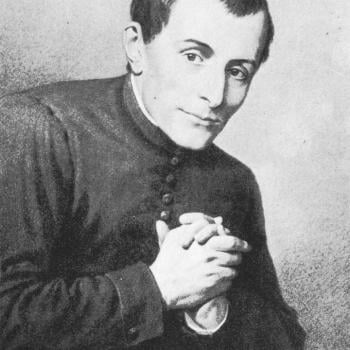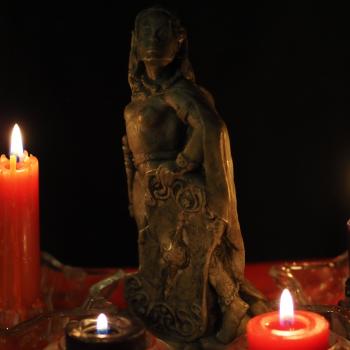Editors' Note: This article is part of the Patheos Public Square on Religion and Visual Art. Read other perspectives here.
The red and blue painted menorah with gold strips unsettles me. It is the frontispiece of the Book of Matthew, an illumination striking in its clearly Jewish symbolism for the opening of a biblical gospel central to Christianity. The name of Hagar in the genealogy of Christ is written in Arabic, and at the top of the base of the menorah is a disk — concentric circles, and a swirl in the middle, Buddhist perhaps. I can't deny Jesus' Jewishness or that Hagar became a figure respected among Muslims. But what to do with the disk?
I veer off toward another display of pages at the Minneapolis Institute of Art. The Christian artist Bruce Herman has said that the art world dismisses contemporary "sincerely meant religious work." Yet here I was ten years ago contemplating no less than a modern-day biblical work in a secular place — the early portions of The Saint John's Bible, an illuminated manuscript Bible rare in its production since the 15th-century invention of the printing press.
What vexed me in the frontispiece would correspond with what would compel me as I later read about first-millennium Anglo-Irish illuminations of scripture: the Lindisfarne Gospels and the Book of Kells. The page featuring a Chi-Rho, the symbol of two letters starting the word "Christ" in Greek, in the Book of Kells has been called "the marriage of pagan superstition and Christian belief" (Miranda Green, Celtic Art: Symbols & Imagery). Is there value to the tension I felt when examining the menorah and the tension that others assume upon study of Anglo-Irish illuminations? Are the supposed incongruences reconcilable?
Illumination is to embellish, often in gold, typically on vellum made from calfskin. The gold indicates God's glory. Unlike Muslim illuminated manuscripts, most Bible illuminations showcase pictorial representations. This freedom was fostered, according to manuscript scholar Michelle P. Brown, by Pope Gregory the Great. Near 600 A.D., he penned the following to the Bishop of Serenus of Marseilles, preventing the obliteration of images:
It is one thing to adore a picture, another to learn what is to be adored through the history told by the picture. What Scripture presents to the readers, a picture presents to the gaze of the unlearned. For in it even the ignorant see what they ought to follow, in it the illiterate read (Michelle P. Brown, The Lindisfarne Gospels: Society, Spirituality and the Scribe).
But illuminations are more than pictures. "The illuminations are not illustrations. They are spiritual meditations on a text," says the chair of the committee who helped to direct the theology of The Saint John's Bible.
When I first observed the neat columns of rounded script at the opening of Genesis in The Saint John's Bible, I was arrested by verse two of the first chapter, "a wind from God swept over the face of the waters" (NRSV). The words were different from the texts of my youth where the Spirit of God, not the wind, was "moving" or "hovering" over the waters. Superimposed over the Genesis illumination to the left was a simple black bird. Was it a shadow of the Holy Spirit as a dove or a reminder of another bird newly created? And yet, did it matter when the tiny gold squares building up to the seventh day revealed the handiwork of God in creation?
For The Saint John's Bible, visual meditations echo the distinctly Benedictine way of prayer of St. John's Abbey in Minnesota, the patron and theological guide. Lectio divina is a slow, imaginative reading of scripture. Reading an illuminated Bible is not an efficient, consumeristic process. The beauty of the calligraphy decelerates the eye; the gold leaf throughout startles the reader with God's glory, the golden images of Christ symbolizing his divine yet human nature. The brilliant color vivid from the vellum's translucence gives us joy.
Similarly, Brown sees the illuminations of the Anglo-Irish monasteries as "multi-valent," layered with multiple meanings. She describes details from the images of the four evangelists in the Lindisfarne Gospels, symbol after symbol, such as the more recognized animal associated with Matthew, Mark, Luke, or John, to a tiny depiction of a curtain being drawn perhaps to indicate a believer no longer needs a "veil" (a curtain in the tabernacle) for approaching God. These symbols are not conveyed directly in the text.
The rich variety of symbolism includes the multicultural and what appears to be multifaith representation in both the Anglo-Irish manuscripts and the contemporary Benedictine one. In the Lindisfarne Gospels, it is an appropriation of Germanic, Coptic, and Mediterranean influences in a Celtic style surrounded with interlacing. The introduction to John's Gospel contains a letter with a terminal (end of a line) that has the figure of a head. Many other terminals feature animals, and in the Book of Kells, more human heads sprout from letters. Although fiercer beasts of the pre-Christian Celtic art have been replaced with gentler sorts (see Ruth and Vincent Megaw's Celtic Art: From Its Beginnings to the Book of Kells), this kind of imagery is an example of what the scholar Françoise Henry called "half-disguised figurations of Celtic gods" (Green, Celtic Art).




